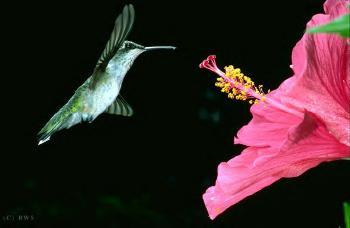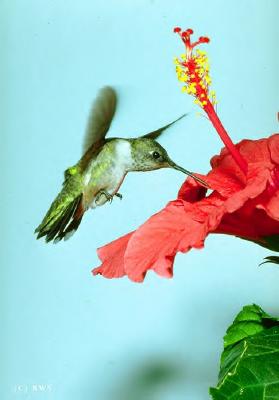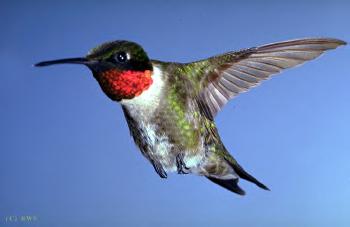|
Ruby-throated Hummingbird (Archilochus
colubris)
 The
Ruby-throated Hummingbird (Archilochus colubris) is the most common
and widely distributed of the hummingbirds in North America. Its minute
size, temperament, and behaviour are fascinating, and its skillful flight
and migration are amazing. All these things set it apart among birds. The
Ruby-throated Hummingbird (Archilochus colubris) is the most common
and widely distributed of the hummingbirds in North America. Its minute
size, temperament, and behaviour are fascinating, and its skillful flight
and migration are amazing. All these things set it apart among birds.
Appearance
From the tip of its bill to the tip of its tail the ruby-throat measures
from 7.5 cm to slightly more than 9 cm. No larger than a good-sized
insect, it is often confused with the northern hawk moth, especially
at dusk, as the moth is similar in size, form, and flight.
The male ruby-throat is shiny metallic green above and greyish white
below and has a forked tail. He wears on his throat a splendid gorget
of silky, ruby red feathers, which, depending on how the light strikes
it, looks sometimes orange, sometimes jet black. The female is similar
but has a greyish white throat patch. Her tail is rounded, and some
of the outer tail feathers are marked with white spots. These she often
displays when posturing and in flight. The ruby-throat's bill is long,
straight, and almost as slender as a darning needle.
Flight
 The most remarkable feature about the hummingbird
is its flight. It manoeuvres at incredible speed, rapidly changing direction
in the air and darting away like a tiny green arrow. Unlike other birds,
it can hover in place in the air. Its pointed wings appear to be a blur
in flight. Scientists have been able to establish the rate of the wingbeats,
by means of high speed photography, at about 55 to 75 beats a second. The most remarkable feature about the hummingbird
is its flight. It manoeuvres at incredible speed, rapidly changing direction
in the air and darting away like a tiny green arrow. Unlike other birds,
it can hover in place in the air. Its pointed wings appear to be a blur
in flight. Scientists have been able to establish the rate of the wingbeats,
by means of high speed photography, at about 55 to 75 beats a second.
The rapid wing motion produces a distinct hum, hence the bird's name,
rising and falling according to the wing speed. At great accelerations
the hum sometimes turns into a continuous high note, similar to that
produced by arrows or bullets in flight.
Migration
In earlier times people did not believe that a bird so small and fragile
could fly thousands of kilometres from its breeding range to its wintering
grounds. This gave rise to the legend that the tiny birds travelled
as passengers on bigger birds, such as the Canada Goose.
Now we know that ruby-throats fly south in the fall and north in the
spring. Observers have seen spectacular flights of these tiny birds
flashing by overhead in great numbers at such places as Point Pelee
and Port Stanley on the Great Lakes, especially in the fall. It has
also been established that hummingbirds actually cross the 800 km expanse
of the Gulf of Mexico on their way to and from their wintering grounds
in Central America.
The ruby-throats leave their northern breeding grounds during the second
half of August and the first week of September. The males migrate first,
followed by the females and the juveniles. They return in the same order
in spring, during the last two weeks of May. Banded birds have returned
to the very same place the next spring.
Behaviour
 When the male hummingbird arrives in the spring, he
establishes a territory containing several sources of food. Because
these sources of food are of great importance, the area may be shared
by other males as well as females. When the male hummingbird arrives in the spring, he
establishes a territory containing several sources of food. Because
these sources of food are of great importance, the area may be shared
by other males as well as females.
Both the males and the females aggressively defend their food supply
and its surroundings against intruders. These encounters lead to persistent
swift pursuits that sometimes develop into fighting. The tiny bird uses
speed and the hum of its wings to intimidate intruders. It employs certain
flight patterns in these aggressive displays. In one, the bird makes
a speedy dash, describing a horizontal U, from side to side around the
intruder's ears. In another, the bird swings vertically up and down
like a pendulum. Both flight patterns are accompanied by high squeaky
notes, and the bird's wings hum like an angry bumblebee. The ruby-throat
is persistent and continues to worry the intruder until it has had enough
and flees.
A spectacular feature of the ruby-throat's courtship behaviour is the
male's famous pendulum display, an elaboration of the aggresive flight
display. The male dives down towards the resting or feeding female.
Like a pendulum he sweeps past her and up to a point 2– 3 m in the air,
then back along the same path in reverse. He repeats this swinging display
time and again, all the while uttering squeaky notes. As he dives past
the female his wings hum the loudest; as he swings closer to the female
his hum becomes more intense and his speed increases. Abruptly, the
display ends; both dart off together, to start again elsewhere.
After the pair has mated, the male takes no part in raising the young.
He spends his time darting from flower to flower sipping nectar, or
sitting for hours atop a selected lookout watching for small insects.
Food and feeding
 The ruby-throat's principal food consists of small
insects and the nectar of flowers. The insects are caught on the wing
from lookout perches or in and around the flowers. To lap up the honey,
the bird inserts its long extensible tubular tongue deep into the honey
wells of the flower, preferring tubed flowers, such as bee balm and
columbines. When feeding from a larger flower with a very deep honey
well, such as a tiger lily, it pierces the calyx, or neck, with its
bill and by this shortcut extracts the drop of honey. The ruby-throat's principal food consists of small
insects and the nectar of flowers. The insects are caught on the wing
from lookout perches or in and around the flowers. To lap up the honey,
the bird inserts its long extensible tubular tongue deep into the honey
wells of the flower, preferring tubed flowers, such as bee balm and
columbines. When feeding from a larger flower with a very deep honey
well, such as a tiger lily, it pierces the calyx, or neck, with its
bill and by this shortcut extracts the drop of honey.
Bright-coloured flowers that contrast sharply with the background attract
the hummingbird. It favours red flowers, followed by orange, which show
up well in dark shady places, and visits green flowers only when the
background foliage is another colour. The hummingbird, like the bee,
contributes to cross-pollination. As it visits one flower it is dusted
with pollen, which it carries to another flower of the same species.
Yellow-bellied Sapsucker borings that release the sap of trees are also
important food sources. The ruby-throat is often seen gently buzzing
a sapsucker in the expectation of being led to another food source.
Hummingbirds are easily attracted to feeders containing a solution of
one part sugar to four parts water. This should be boiled to forestall
fermentation, and the mixture should be changed at least once a week.
The hummingbird is a curious creature. Some birds take to a feeder at
once; others learn to associate the strange contraption with sweet food
only with difficulty, and a dash of red or orange paint applied to a
new feeder helps. But once a feeder is found, neither its form nor its
colour is of any account, as long as it is hanging in the same place.
A hummingbird returning in spring always looks for the feeder where
it last fed from it eight months before.
The hummingbird also drinks water. Flying across open water, it may
descend like a swallow to the surface, touching it with the bill and
leaving widening rings on the water to mark the site of the drink.
Enemies
 Inclement weather, such as storms and untimely frost,
is one of the most serious threats to the hummingbird's life. It is
vulnerable to insect-eating hawks and other predators, as it looks so
much like an insect. There is one instance on record of a hummingbird
flying over a pool being caught and swallowed by a fish. Accidents also
appear to play a significant role. Hummingbirds are sometimes caught
in spider's webs, or otherwise entangled and unable to extricate themselves,
or are impaled on a thorn or other sharp object. Inclement weather, such as storms and untimely frost,
is one of the most serious threats to the hummingbird's life. It is
vulnerable to insect-eating hawks and other predators, as it looks so
much like an insect. There is one instance on record of a hummingbird
flying over a pool being caught and swallowed by a fish. Accidents also
appear to play a significant role. Hummingbirds are sometimes caught
in spider's webs, or otherwise entangled and unable to extricate themselves,
or are impaled on a thorn or other sharp object.
The delicately changeable colours of their plumages, their diminutive
sizes in combination with temper and spirit, and their agility and endurance
in flight are the principal characteristics that have given Ruby-throated
Hummingbirds their place of distinction among birds.
|